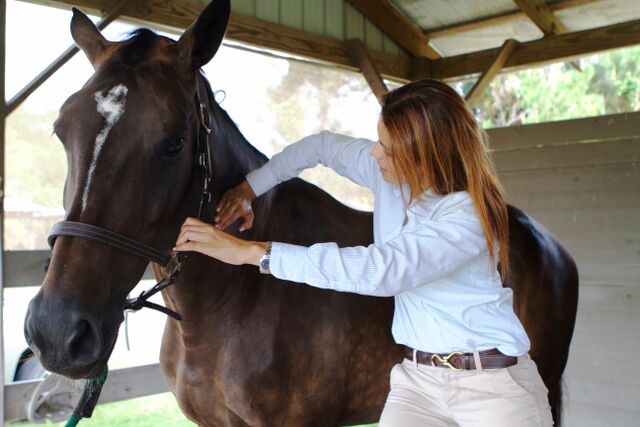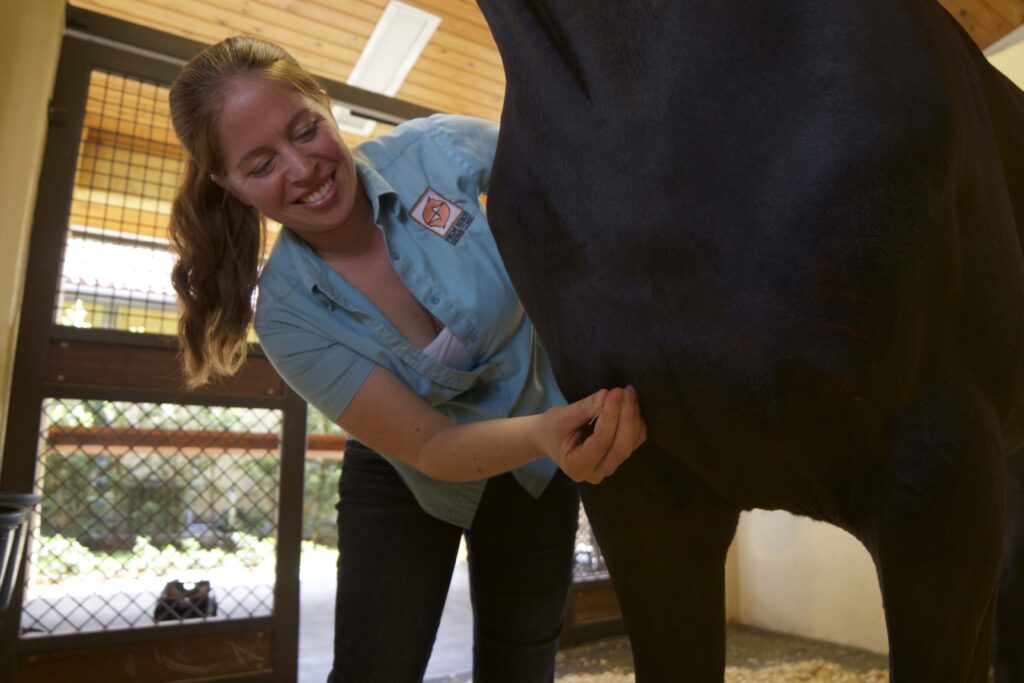Tag: novoa

In order for top-level performance horses to compete at their best, they must have full range of motion throughout their bodies as well as the ability to move freely. When a horse is out of alignment, a joint, whether it is in the spine or elsewhere in the body, is restricted in its normal range of motion. Veterinary medical manipulation, or what is known as a chiropractic adjustment in humans, is a form of alternative medicine that aims to solve this issue. The goal of any adjustment is to restore the optimal range of motion to that joint, which will subsequently alleviate inflammation in and pressure on surrounding nerves and soft tissue.
Dolton, a nine-year-old Hanoverian gelding owned by Karin Flint, is a well-known name in the para-dressage world. The gelding won two individual gold medals with Roxanne Trunnell at the 2020 Paralympic Games in Tokyo, Japan. Dolton was special from a young age and won his first bronze medal when he was only six years old at the 2018 FEI World Equestrian Games. The pair is trained by Andrea Woodard, who often rides Dolton herself and stays very involved in all aspects of his care. Woodard and Dr. Natalia Novoa of Palm Beach Equine Clinic, who have worked together to treat Woodard’s own horses, thought Dolton could benefit from medical manipulation.
“What I found with Dolton was very common with any dressage horse,” noted Dr. Novoa. “When working with Dolton I make sure that he is correctly aligned. I also address any pinched nerves, tight muscles, tight myofascial, and anything else that could create pain. I saw that the adjustments and the myofascial release were very beneficial for him.”
When a horse is out of alignment, it may result in their gait appearing different than usual, even at a walk. If one area of the body is not functioning properly, horses have to compensate, which can result in many common sport horse injuries. Medical manipulation aims to fix this issue by applying varying amounts of pressure to specific segments of the horse’s body, mainly focusing on the spine. This form of manual therapy, performed by a certified practitioner, often targets joint issues and muscular development. Additionally, medical manipulation can help in stimulating nerve reflexes and reducing pain.
“I like that I can tell Dr. Novoa what I’m feeling, and she tells me what she feels,” described Woodard. “We trust each other’s judgment, which helps in pinpointing where the issue is in the horse. Sometimes it’s something in Dolton’s body that’s not sitting how it’s supposed to. If something is out of position and Dolton is not moving how he is supposed to, other parts of his body can get sore.”
If done routinely, medical manipulation can benefit a horse’s natural balance, topline, and overall performance while also aiding in pain and soreness relief. Once Dr. Novoa began working with Dolton on a regular basis, it became easier for her to not only focus on the areas he needed help with the most, but also to fix them.

“The more I continued working with him the better he performed,” commented Dr. Novoa. “We were able to identify the misalignments and any patterns so that we could more easily correct them. He was progressively more comfortable with treatments as we continued with a regular program in place because he knew what to expect. He is a very sensitive horse. I know his areas of strength and weakness, so we developed a system that works for him, and we continue to have great results.”
Being certain that Dolton’s body is functioning properly is extremely important in para-dressage. Flint makes sure that both Woodard and Dr. Novoa are integral in his care so that Trunnell and Dolton can be confident stepping into the ring.


“With para-dressage you never know what you’re going to get that day with your body,” described Flint. “This means that it is really important to know what horse you’re getting. That’s why chiropractic work, all their care, and overall health is so important.
“The reason we like Dr. Novoa is that she’s very knowledgeable about the physics and mechanisms of the horse,” continued Flint. “Someone who isn’t familiar with this can do more damage, which is true with humans too. Someone who doesn’t listen to signals can end up putting the horse in more pain. She is very, very good at what she does.”
Sport horses are able to perform at their best when they are comfortable and have proper range of motion throughout their body. It is helpful to have horses examined by a certified veterinary medical manipulation practitioner to check that their body is moving properly and to decrease the chance of an injury due to compensation. Call Palm Beach Equine Clinic today at 561-793-1599 to set up an appointment.
Palm Beach Equine Clinic is the only equine veterinarian based in Wellington, FL, with the powerful SmartRLT Laser.
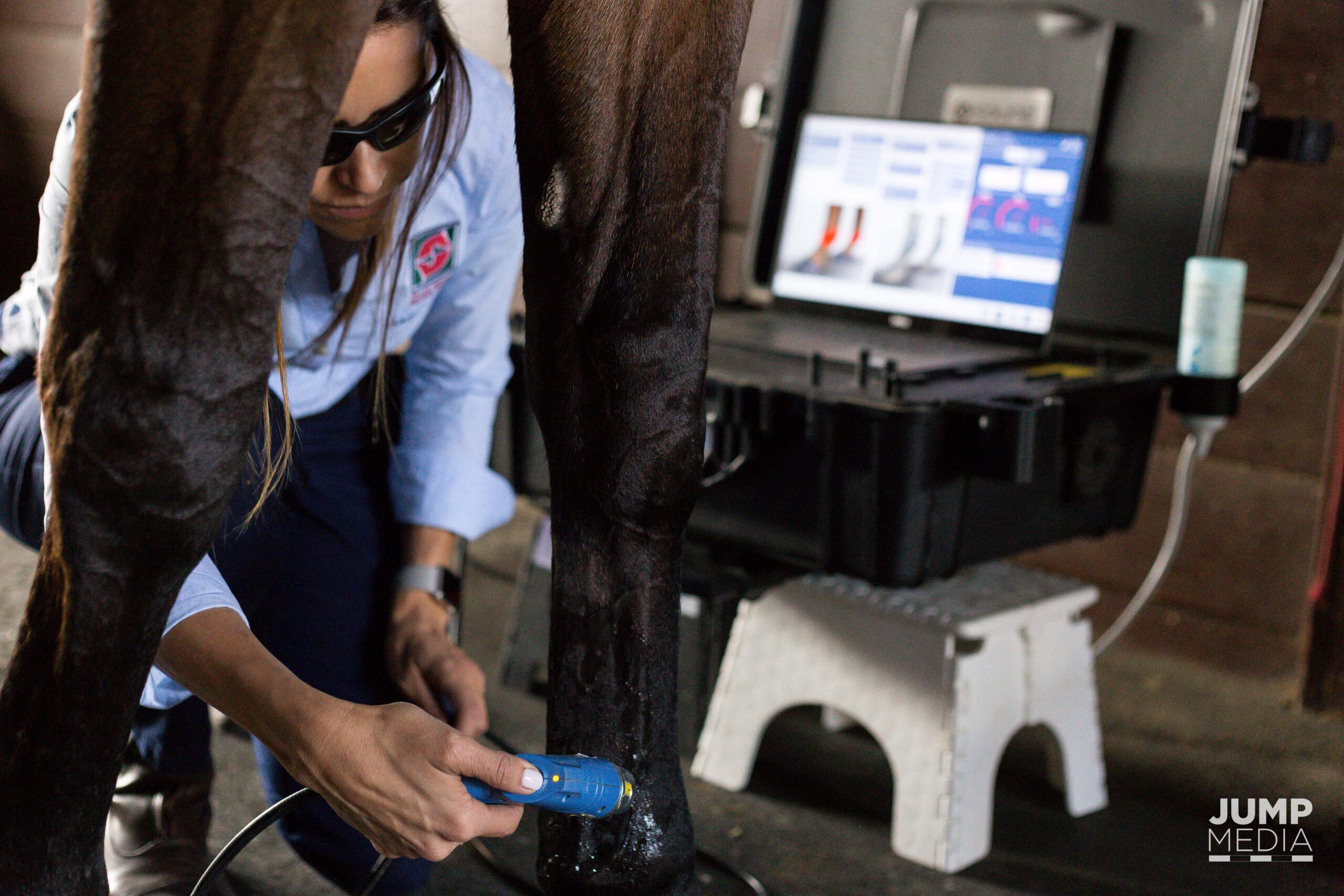
Dr. Natalia Novoa utilizes this revolutionary sport horse medicine tool to treat a variety of injuries and wounds with clinically documented success. The SmartRLT laser is a portable Class IV laser, the most potent and dynamic on the market, as an essential non-invasive therapy for use in the barn and at horseshows. Not only is Dr. Novoa’s regenerative laser extremely effective in treating injuries that were previously considered career-ending, but it is also especially beneficial for enhancing body condition and performance of the equine athlete.
Clinical and scientific results of the SmartRLT include:
- Repair of ligament and tendon lesions
- Reduces scar tissue within and around injuries
- Reduces inflammation
- Increases collagen production
- Increases blood circulation to bring nutrients to the site
- Realigns muscle fibers for stronger healing
- Provides analgesia (reduces pain)
- Enhances tissue oxygenation
- Increases cell proliferation (generates more cellular energy)
Regenerative Laser Therapy has successfully treated injuries to structures such as:
- Cartilage/bone/joints
- Neck and poll, stifles, temporo mandibular joint (TMJ), hocks, fetlocks, and coffin joint
- Sore feet and laminitis
- Sore muscles (especially back and gluteal)
- Suspensory ligaments and branches
- Superficial flexor tendons
- Deep digital flexor tendon and its insertion inside the hoof
- Inferior and superior check ligaments
- Collateral ligaments
- Summer sores and scratches
- Scar tissue
- Open wounds and punctures
- Sub-dermal infections
- Post-operative incisions
- Sacroiliac joint and kissing spine
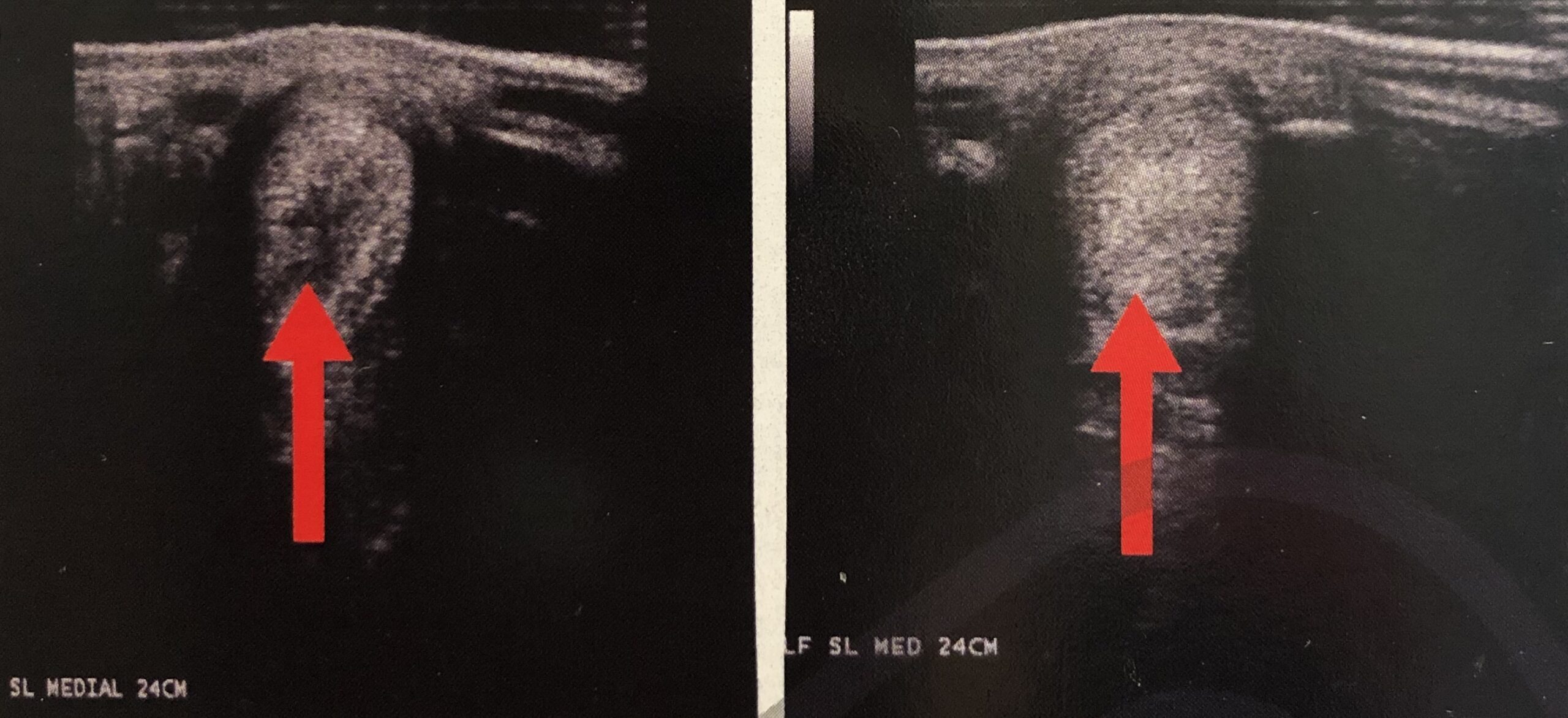

Regenerative Laser Therapy Case Study: Lameness
| Patient Condition | Grand Prix level show jumper with left front lameness. |
| Evaluation | Magnetic Resonance Imaging (MRI) showed intra-osseous fluid accumulation in the left front third metacarpal condyle. |
| Treatment | 20 sessions of Dr. Novoa’s SmartRLT. |
| Result | Fluid in the third metacarpal condyle was resolved. |

Custom Treatment for Your Unique Horse

Dr. Novoa’s SmartRLT is a pioneering technology that has evidence-based settings and treatment protocols to optimize the effectiveness for each unique patient. Treatments are customized for the specific structure, acute or chronic conditions, deep to superficial and skin pigmentation to reach the best outcomes.
Regenerative Laser Therapy provides a warm, soothing sensation and does not require sedation. Treatments can be performed at the barn or horseshow. Be sure to share your competition schedule with your veterinarian so treatments can be done within a safe and legal timeframe.
General Protocols for Regenerative Laser Treatments
Pre and Post Performance: 1-3 sessions
Acute Conditions: 6-10 sessions for the first two weeks
Chronic Conditions: 2-3 sessions per week for approximately 10 weeks
Laser Therapy 101
Laser therapy is beams of electromagnetic energy that interact chemically and biologically with the targeted tissue or injury. This creates photobiomodulation, allowing maximum penetration of tissue structures. Laser therapy releases endorphins while increasing cellular activity, blood flow and enhancing tissue oxygenation. Essentially, it enhances the body’s natural healing mechanisms and expedites the restorative process.

Regenerative Laser Therapy goes far beyond standard lasers.
Regenerative Laser Therapy releases greater energy per pulse to create a photomechanical effect at the cellular level. It can be directed to the target injury or lesion to regenerate, revitalize, remodel, repair and realign tissue. Therefore, it is essential for equine sports medicine, lameness, rehabilitation and optimizing performance.
Regenerative Laser Therapy may only be administered by a veterinarian. Dr. Novoa is the only veterinarian based full-time in South Florida offering the SmartRLT treatments.
Palm Beach Equine Clinic combines the best of conventional and alternative medicine to provide comprehensive, full-body care to both sport and companion horses. Dr. Natalia Novoa specializes in utilizing the best of both approaches to provide unmatched results.
“I believe that treating issues with both alternative therapies and conventional medicine is a perfect approach,” said Dr. Novoa, who has been a full-time member of Palm Beach Equine Clinic since 2011. “We can’t exchange one for other, and the combination usually makes for a great treatment plan.
“A chiropractic adjustment is an alternative therapy that I absolutely recommend,” continued Dr. Novoa. “It’s very useful for a horse that has injuries or soreness issues, but it’s also something that is very important for maintenance. You want to prevent problems instead of treat them. If a misalignment happens, that creates incorrect friction, which then leads to pain in the joints, muscle soreness, and stress on the tendons and ligaments, possibly leading to a soft tissue injury. Another advantage of chiropractic adjustments is that it is useful for FEI competition horses because of the restriction on medications at that level. It’s a way we can effectively treat a problem and stay within the regulations.”
According to Dr. Novoa, veterinarians who incorporate chiropractic adjustments in their treatment options do so with their own style. She has developed a system that she finds most effective, and her secret is out!
Dr. Novoa’s five steps to a chiropractic adjustment:
1. Horse History
Patient history is a pillar of medicine, which provides pivotal information.
“I always want to speak with riders, trainers, and grooms to get an understanding of what they feel and see,” said Dr. Novoa. “They spend the most time with the horse and know it the best. Sometimes, clients ask me to evaluate the horse first and tell them what I see and feel, which is when most people ask me if I have a crystal ball.”
While Dr. Novoa doesn’t travel with a crystal ball, her skill at reading a horse leads her to the second step.
2. Scan Acupuncture Points – “Acuscan”
A scan of the acupuncture points on a horse, which Dr. Novoa calls an “acuscan,” is always her next move. She checks the main acupuncture points from head to tail by using her tool of choice – the round end of a needle cap. This allows her to put firm pressure on a very specific point and then evaluate the horse’s reaction to that pressure.
“A reaction can indicate, for example, left front lameness or a sore neck, etc.,” said Dr. Novoa. “It’s not voodoo; you are piecing together your findings in the exams with the symptoms that the horse is presenting.”
3. Evaluate Horse Movement
After scanning the horse, Dr. Novoa likes to always see the horse move to dig deeper into any reactions she noticed while checking acupuncture points. She starts at the walk and then observes at the trot.
“This is where I incorporate conventional medicine and supplement my evaluation with flexion tests or hoof testers depending on what I see,” said Dr. Novoa. “I want to produce the most detailed picture before moving on to the adjustment.”
4. Make the Adjustments
“I adjust a horse the same way every time,” said Dr. Novoa. “This specific order ensures that I don’t miss anything and the horse receives a thorough adjustment of its entire body with special attention paid to any problem areas that I uncovered earlier in the process.”
Check and adjust these 10 points:
Point 1: TMJ (temporomandibular joint)
Point 2: Poll and neck
See fig. 1 & 2
Point 3: Front limbs, including lower limb joints and carpus (knee)
See fig. 3
Point 4: Shoulder and scapula on both sides to compare one with the other
Point 5: Withers
Point 6: Pelvis and back
See fig. 4




Point 7: Hind limbs, including hocks and stifles
Point 8: Sternum and T1/T2 vertebrae
Point 9: Tongue release
Point 10: Myofascial release if muscles spasm or a tense back and neck are indicated
5. Secondary Acupuncture Point Scan
“The final piece of the puzzle is to scan the acupuncture points again to compare what we had before versus what we have after the adjustment,” said Dr. Novoa. “If there are still reactions, I may do acupuncture or electro-acupuncture and utilize a class four regenerative laser.”
After her secondary scan, Dr. Novoa formulates a short and long-term treatment plan. In her experience, adjustments last for four to six weeks before a follow-up adjustment is indicated. If certain chronic injuries are flaring up, a horse may need an earlier follow-up.
“It’s all about listening to the horse. They will always tell you what they need; you just have to listen!”
Dr. Novoa
Whether it’s for an Olympic hopeful or a reliable trail horse, Palm Beach Equine Clinic has more than 30 years of proven success keeping horses healthy and happy while working to extend their performance careers. In addition to innovative veterinary services that utilize advanced diagnostic tools and surgical equipment, Palm Beach Equine Clinic also offers alternative therapies to optimize health and increase the longevity of the horse’s performance career.
Veterinary chiropractic manipulation, acupuncture, and Chinese herbal medicine are three alternatives to standard medical treatments offered at Palm Beach Equine Clinic. While all of Palm Beach Equine Clinic veterinarians are versed in the many aspects of equine medicine, several of the doctors have studied extensively in alternative therapies. Dr. Natalia Novoa treats horses with chiropractic manipulation and acupuncture, and Dr. Janet Greenfield-Davis focuses on acupuncture treatment and uses Chinese herbal medicine to bring out the best in her patients.
Alternative Therapies for a Competitve Edge

“The line between success and failure is very thin for performance horses, and a lot of these alternative therapies can be very useful in giving the horse that little bit more,” explained Palm Beach Equine Clinic’s Dr. Richard Wheeler. “Chiropractic and acupuncture are just two of the alternative therapies that we offer. They are both conjunctive therapies that can keep horses comfortable, happy and performing well.
“Both chiropractic manipulation and acupuncture can get the horse moving and feeling better, and help to maintain some minor chronic problems that they may have, therefore avoiding more invasive treatments,” Dr. Wheeler continued. “For neck or back pain, once we diagnose a problem, we may treat it and then follow up with a program of alternative therapies. These therapies are used with the aim of keeping the horse supple and moving with ease and helping the musculature to work correctly. We work with the trainers to optimize muscle development so that we can fix the problem and keep the horse moving forward and performing at their top level.”
Alternative Therapy: Equine Acupuncture
Fellow Palm Beach Equine Clinic veterinarian, Dr. Janet Greenfield-Davis is skilled in acupuncture and herbal medicine. Acupuncture is a form of treatment used in both traditional and classical Chinese medicine. It is based on the principle that there are energetic pathways, or channels, throughout the body that influence associated internal organs and structures. Energy from these pathways surfaces at various points on the body, identified as acupuncture points. Extremely fine gauge needles are inserted at selected points, stimulating these points and thereby activating the body’s natural healing abilities.
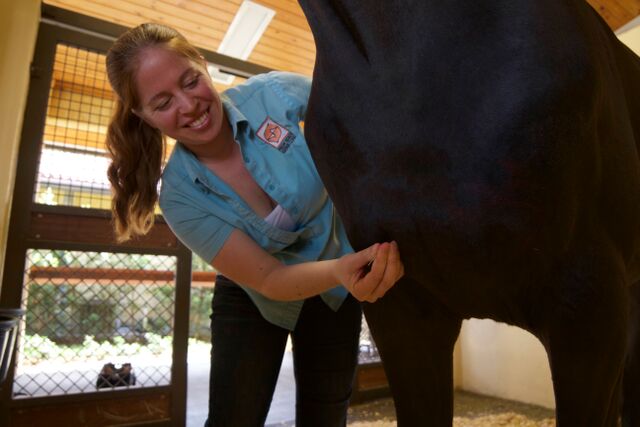
“We offer acupuncture, chiropractic and herbal medicine as an alternative or adjunct therapy to your current veterinary protocol,” Dr. Greenfield-Davis explained. “With acupuncture, we stimulate particular points that can relieve pain, increase endorphins, calm, and improve health and body function in horses. These specific points have a high capacity of nerve endings, lymphatic vessels, and blood vessels, as well as hormone stimulation.”
Clinical trials indicate that acupuncture may be an effective adjunct therapy for musculoskeletal problems such as muscle soreness, back pain, disc problems, osteoarthritis, and degenerative joint disease. Acupuncture may help neurological disorders such as laryngeal hemiplegia, and facial and radial nerve paralysis. It can help with gastrointestinal disorders including diarrhea, gastric ulcers, colic, and impaction. Acupuncture may also help with respiratory diseases, metabolic and endocrine diseases, and other chronic conditions, such as anhidrosis, heaves, asthma, cough, uveitis, and behavioral problems.
Alternative Therapy: Veterinary Chiropractic Manipulations
Alternative therapies such as acupuncture and chiropractic manipulation are increasingly popular amongst sport horse owners, and Palm Beach Equine Clinic’s Dr. Natalia Novoa offers both forms of treatment.
“Chiropractic adjustment is an excellent complementary modality that can be used for diagnosis, treatment, and prevention of selected neuromusculoskeletal disorders,” Dr. Novoa explained. “The practice of chiropractic focuses on the relationship between structure (primary spinal column) and function (coordinated by the nervous system) to restore it. The goal is to treat soft tissue injuries or articular dysfunction to optimize health through manual therapy and to detect and treat abnormalities and alleviate pain.”
Veterinary chiropractic manipulation is thought to optimize equine health by restoring the normal joint motion, reversing mild pathology, and helping to slow the progression of degenerative joint and spine disease. Over the years, this therapy has become a valuable adjunct for competition horses.
Chiropractic manipulation is also a great treatment option for horses that suffer neck and back pain, nerve damage, poor performance, behavioral problems, muscle spasms, localized or regional joint stiffness, unexplained lameness, gait abnormalities asymmetry/muscle imbalance/atrophy, injuries resulting from falls, trauma (such as slips, getting cast in the stall, or missteps), or poor fitting equipment.

“I identify the restricted movement or subluxations by manipulating and evaluating the joint mobilization. Then I restore the joint motion with an adjustment, which is a manually controlled force applied to a specific joint,” Dr. Novoa said of the process. Chiropractic and acupuncture therapies are complementary treatments for lameness problems and other issues. They are alternative methods and do not replace conventional veterinary medicine or surgery, but can be very useful in maintaining top performance levels in your horse.
“There has been an increase of interest in non-traditional therapy, and Palm Beach Equine Clinic is aware of its great value, so we provide the services to allow our horses to reach maximum performance potential and overall health,” Dr. Novoa concluded.
Meet PBEC Veterinarian Dr. Natalia Novoa
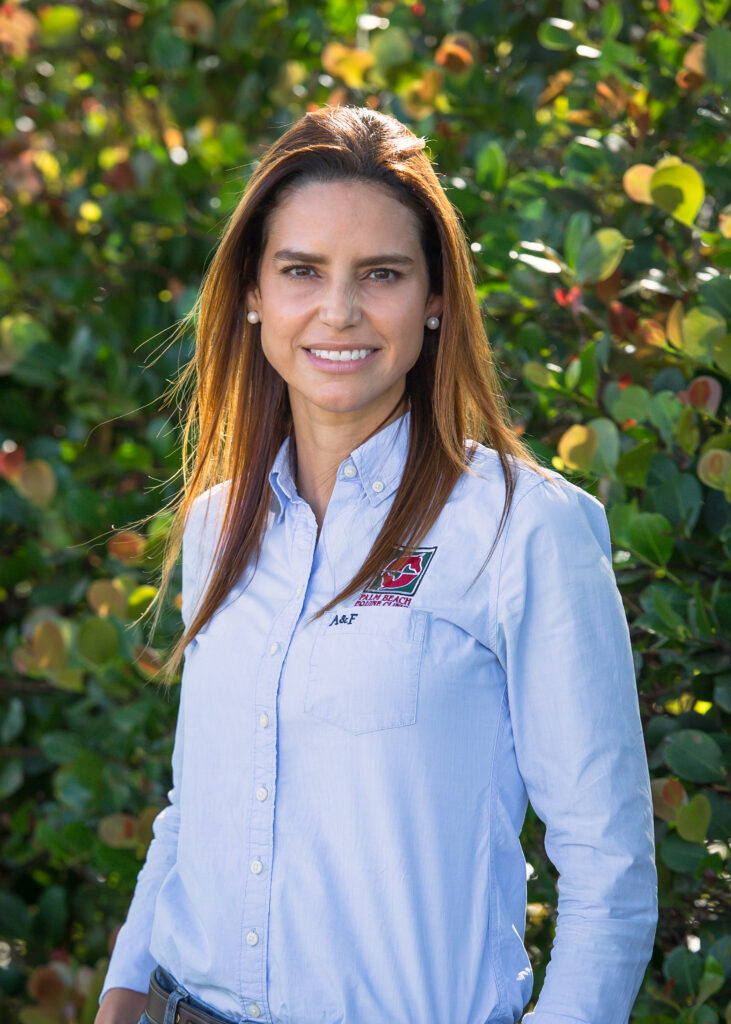
Dr. Natalia Novoa was born in Nashville, TN, and raised in Colombia, where she graduated from the University of La Salle. Upon returning to the United States, Novoa validated her degree in both the U.S. and Canada and received her chiropractic adjustments qualifications in Kansas and studied acupuncture in Florida. Novoa joined the Palm Beach Equine Clinic (PBEC) team for a short period in 2000, before spending several years following the hunter/jumper horse show circuit in Canada, Colorado, and Ocala, FL. She then re-joined the PBEC staff in 2011, and, with her veterinary license in Florida, Kentucky, North Carolina, and Canada, Novoa has been a valued member of their team ever since.
Q: How did you decide that you wanted to pursue veterinary medicine?
I have enjoyed having animals in my life since I was very young, but what was key to me deciding to pursue veterinary medicine was having a farm where I was able to gain skills and real-world experience that would prove handy down the road. I was able to practice with real medical cases and acquire knowledge in operational management, and it was an introduction to the lifestyle because it requires patience, hard work, commitment, determination, and accountability. It was a valuable opportunity to work hands-on in the environment with the veterinarian of my farm, absorbing, assimilating, and getting familiarized with the vet skills that were the building blocks for my future. He made me realize that veterinary medicine would fit me perfectly. That helped me set the foundation for my career, and since then, I didn’t have to look any further!
Q: What led you to PBEC?
I think of it like this: if I want to become the best at what I do then I have to work with the best, and I picked PBEC. They say, “Leadership is not about a title or designation. It’s about impact, influences, and inspiration.” Palm Beach Equine assumes the leadership role, chases the latest trends, and evolves continuously. In addition, we have a great team of skilled vets and staff who try to expand their vision and abilities to achieve success.
I have to say I have had seven great horse show seasons with Palm Beach Equine, and I’m looking forward to an eighth one. When you are doing what you love and you are working with great horses, time flies.
Q: What is your primary area of focus?

I focus on sports medicine and lameness, combining conventional medicine with alternative medicine; this includes chiropractic adjustments, acupuncture, and herbal therapy. To me those are great alternative tools for diagnosis and treatment. I have to say, they help you to look at a horse or a dog in a different way, and you have more tools and options. Regardless of the case – lameness, pain management, internal medicine, etc. – I have different choices to achieve results in those situations.
I perform chiropractic adjustments, acupuncture therapy, and laser treatments to small animals as well. Most horse people have dogs, so I’m able to take care of their companions too.
Q: What is a typical day like for you at PBEC?
It’s a busy agenda every day with continuous juggling. I’m usually dealing with lameness (involving diagnosis and treatment), doing pre-purchase exams, chiropractic adjustments, acupuncture therapies on horses and dogs, performing laser treatments, and at the end of the day, doing paperwork. Depending on the day, I could be doing FEI treatments, vet shift at the horse show, donating vet work at Vinceremos Therapeutic Riding Center, or dealing with an emergency. We’re a very mobile practice able to go from farm to farm and horse show to horse show (Kentucky; Tryon, NC; Ocala, FL), so I’m moving around a lot.
Q: What is your favorite part of the job?
There are so many aspects that I enjoy: working outdoors, closely with animals on a daily basis, and diagnosing and dealing with different issues to overcome problems; the privilege of working as a team with the clients and trainers and creating a great, close relationship with them; the connection with the animals and how they show you how grateful they are, and being able to see the improved outcome. There’s great satisfaction in successfully applying my knowledge and skills to a make a difference in someone’s life.

Q: Have you had any standout, favorite moments since beginning to work at PBEC?
When I had double success treating a ‘mystery’ case of a horse in which the owner was losing hope because other treatments were not showing good outcomes, and also treating her dog that was crying and unable to get in the car. The animals and owners were both happy and thankful. “For it is in giving that we receive” – having a positive impact on someone is correlated with high levels of overall job satisfaction.
Q: What do you enjoy doing outside of work?
I enjoy traveling with my daughter, Lola, and visiting my parents and siblings that live in different countries. I also love dancing to Latin music, running, playing tennis and squash. I’m a pretty competitive squash player, so I welcome any challengers!

For over 30 years, Palm Beach Equine Clinic (PBEC) has offered an unwavering commitment to the care of your horse, whether an Olympic athlete or reliable trail horse. PBEC’s goal is to keep your horse healthy and happy while extending their performance career. PBEC offers innovative veterinary services with the assistance of state-of-the-art diagnostic tools and surgical equipment. They also offer several equine alternative therapies that can optimize your horse’s health and increase the longevity of their career.
Veterinary chiropractic manipulation, acupuncture, and Chinese herbal medicine are three alternatives to standard medical treatments offered at PBEC.
While all of PBEC’s 28 veterinarians are versed in all methodologies of equine medicine, several of the doctors have studied extensively in equine alternative therapies. Dr. Natalia Novoa treats horses with chiropractic manipulation and acupuncture. Dr. Janet Greenfield-Davis focuses specifically in acupuncture treatment and also uses Chinese herbal medicine to bring out the best in her patients.
PBEC’s Dr. Richard Wheeler spoke of how equine alternative medicine can be used to improve your horse’s chance for success and treat many different issues.
Alternative Therapies for Performance Horses
“The line between success and failure is very thin for performance horses, and a lot of these alternative therapies can be very useful to give the horse that little bit more,” Dr. Wheeler explained. “Chiropractic manipulation and acupuncture are two alternative therapies that we offer. They are both conjunctive therapies that can keep horses comfortable, happy and performing well.”


“Both chiropractic manipulation and acupuncture can get the horse moving a little bit better and can help to maintain some minor chronic problems that they may have, therefore avoiding more invasive treatments,” Dr. Wheeler continued. “For neck or back pain, once we diagnose a problem, we may treat it and then follow up with a program of equine alternative therapies. These therapies are used with the aim of keeping the horse supple, and moving with ease, and helping the musculature to work correctly. We work with the trainers to optimize muscle development so that we can fix the problem and keep the horse moving forward and performing at the top level.”
Equine Acupuncture
Dr. Janet Greenfield-Davis is one of the veterinarians at PBEC that is skilled in acupuncture and herbal medicine. Acupuncture is a form of treatment used in both traditional and classical Chinese medicine. It is based on the principle that there are energetic pathways, or channels, throughout the body that influence associated internal organs and structures. Energy from these pathways surface at various points on the body, identified as acupuncture points. Extremely fine gauge needles are inserted at selected points, stimulating these points and thereby activating the body’s natural healing abilities.
“We offer acupuncture, chiropractic and herbal medicine as an alternative or adjunct therapy to your current veterinary protocol,” Dr. Greenfield-Davis explained. “With acupuncture, we stimulate particular points that can relieve pain, increase endorphins, calm, and improve health and body function in horses. These specific points have a high capacity of nerve endings, lymphatic vessels, and blood vessels, as well as hormone stimulation.”
Clinical trials indicate that acupuncture may be an effective adjunct therapy for musculoskeletal problems, such as muscle soreness, back pain, disc problems, osteoarthritis, and degenerative joint disease. Acupuncture may help neurological disorders, such as laryngeal hemiplegia, and facial and radial nerve paralysis. It can help with gastrointestinal disorders, such as diarrhea, gastric ulcers, colic, and impaction. Acupuncture may also help with respiratory diseases, metabolic and endocrine diseases, and other chronic conditions, such as anhidrosis, heaves, asthma, cough, uveitis, and behavioral problems.
Equine alternative therapies such as acupuncture and chiropractic manipulation have gained popularity over the past years. Offering these therapies allows PBEC to treat horses in other ways in addition to their standard practices of equine medicine. Dr. Natalia Novoa is one of the veterinarians at PBEC who offers both chiropractic and acupuncture therapies for clients.
Veterinary Chiropractic Manipulation
“Chiropractic is an excellent complementary modality that can be used for diagnosis, treatment, and prevention of selected neuromusculoskeletal disorders,” Dr. Novoa explained. “The practice of chiropractic focuses on the relationship between structure (primary spinal column) and function (coordinated by the nervous system) to restore it. The goal is to treat soft tissue injuries or articular dysfunction to optimize health through manual therapy and to detect and treat abnormalities and alleviate pain.”


Veterinary chiropractic manipulation is thought to optimize equine health by restoring the normal joint motion, reversing mild pathology, and helping to slow the progression of degenerative joint and spine disease. Over the years, this therapy has become a valuable adjunct for competition horses.
Chiropractic manipulation is also a great treatment option for horses that suffer neck and back pain, nerve damage, poor performance, behavioral problems, muscle spasms, localized or regional joint stiffness, unexplained lameness, gait abnormalities asymmetry/muscle imbalance/atrophy, injuries resulting from falls, trauma (such as slips, getting cast in the stall, or missteps), or poor fitting equipment.
“I identify the restricted movement or subluxations by manipulating and evaluating the joint mobilization. Then I restore the joint motion with an adjustment which is a manual controlled force applied to a specific joint,” Dr. Novoa said of the process.
Complementary Sport Horse Medicine
Chiropractic and acupuncture therapies are complementary treatments for lameness problems and other issue. They are alternative methods and do not replace conventional veterinary medicine or surgery, but can be very useful in maintaining top performance levels in your horse.
“There has been an increase of interest in non-traditional therapy, and PBEC is aware of its great value, so we provide the services to allow our horses to reach maximum performance potential and overall health,” Dr. Novoa concluded.
Palm Beach Equine Clinic provides experience, knowledge, availability, and the very best care for the horses of Wellington. Have them be a part of your team! To find out more, please visit www.EquineClinic.com or call 561-793-1599.
The 2015 Pan American Games were held in Toronto, Ontario showcasing exciting equestrian competition in the disciplines of show jumping, dressage and eventing. Countries from North, South and Central America, as well as the Caribbean, fielded teams for the prestigious event which served to secure qualifications for the 2016 Olympic Games in Rio de Janeiro, Brazil. Palm Beach Equine Clinic was proud to have two of its finest sport horse veterinarians in the middle of the action, providing veterinary support to the world’s elite horses.
Palm Beach Equine Clinic’s Dr. Jorge Gomez was in attendance at the Pan American Games to care for many of his competing clients throughout the event. Dr. Gomez is not only a top sport horse practitioner but is also a board-certified surgeon. Dr. Natalia Novoa was also one of the treating veterinarians at the Games, where she provided conventional veterinary services as well as alternative medicine including chiropractic adjustments and acupuncture for many of the equine stars.
Drs. Gomez and Novoa were witness to great sport and tremendous results during their time in Toronto. The show jumping portion of the Games was held July 18-25, awarding medals for individual and team events. Both veterinarians were fortunate enough to watch the Canadian Show Jumping Team win gold. Argentina went home with the silver medal and the United States earned bronze. They also proudly watched several of their own clients earn top finishes in the individual competition. McLain Ward (USA), Andres Rodriguez (VEN), and Lauren Hough (USA) earned the gold, silver and bronze medals respectively.

There is a great deal of work that is vital to maintaining a world class performance horse in peak condition for an event such as the Pan American Games. Dr. Gomez was selected to be the Team Veterinarian for Venezuela and Guatemala. Dr. Gomez teamed up with Dr. Novoa to provide veterinary support for silver medal winner Darlon van Groenhove with Andres Rodriguez (VEN) and sixth place finisher Hardrock Z ridden by Emanuel Andrade (VEN). Dr. Novoa was honored to work with and care for many of the event’s most successful horses, including Canada’s Tripple X III (Tiffany Foster) and Coco Bongo (Eric Lamaze), Argentina’s Abunola (Luis Pedro Biraben) and Cannavara 9 (Matias Albarracin), and Venezuela’s Darlon van Groenhove (Andres Rodriguez), as well as Hardrock Z (Emanuel Andrade).
“Such success is attained with the contributions of a number of people, including the riders, trainers, owners, grooms, veterinarians, farriers and other support personnel, and I wish to take this opportunity to congratulate each and every person involved,” Dr. Novoa stated. “It is my honor and pleasure to provide veterinary care to such top caliber horses. It is truly exciting to watch these athletes compete at the highest level, earning personal bests, such as Andres Rodriguez winning the Individual Silver Medal for Venezuela! Good luck to everyone in the preparations for the Olympic Games in Rio in 2016!”
Palm Beach Equine Clinic, an industry leader in sport horse veterinary care, features a renowned list of veterinarians who are experts in their respective fields, and available to provide services to clientele throughout North America and around the world in the various horse sport disciplines.
